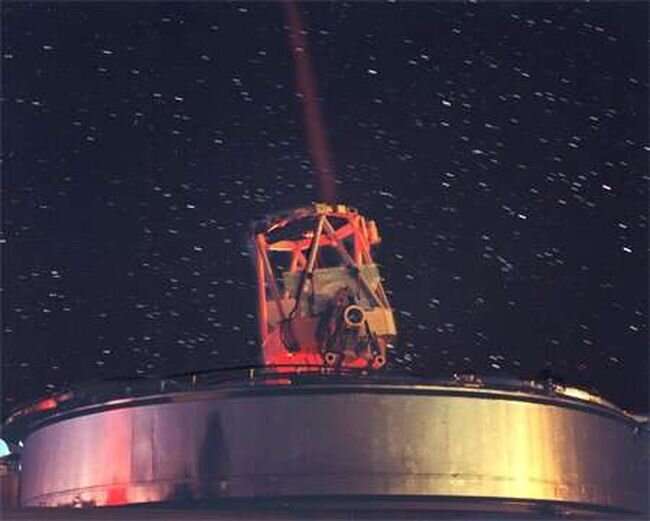Credit: Kirtland Air Force Base
New research, based on two decades' worth of data, shows that in the ten years after its onset in 2000, the Southwestern North American (SWNA) megadrought caused a 30% change in gravity wave activity in Earth's upper atmosphere.
More than 30 years ago, Chester Gardner of UIUC's Department of Electrical and Computer Engineering and Chiao-Yao She of Colorado State University's Department of Physics teamed up to study Earth's middle atmosphere. Using sodium resonance laser radar (lidar), Gardner and She developed and demonstrated an important new technique for measuring temperature profiles in the Earth's upper atmosphere.
Subsequently, they were able to observe changes in upper atmosphere gravity waves at two locations (Albuquerque, New Mexico and Ft. Collins, Colorado) over a 20-year period. Their results, describing how the waves changed following the drought's onset, have now been published in Geophysical Research Letters.
In 1994, a team led by Gardner installed a lidar system on a large telescope at the Starfire Optical Range outside of Albuquerque, NM on the Kirtland Air Force Base. The lidar system measured temperature and winds in the upper atmosphere, using atomic sodium as the target species until late 2000.
Cosmic dust particles that are vaporized in Earth's atmosphere are the source of this atomic sodium. Using a laser beam, atomic sodium can be excited, causing it to glow. A telescope on the ground collects the backscattered light of the sodium fluorescence and computers process that information to derive profiles of sodium density, temperature, and radial wind velocity. She's team at CSU made similar observations at Ft. Collins, CO, eventually compiling an extensive dataset that spanned 20 years from 1990 to 2010.
The discovery of wave activity changes during the megadrought was a fortunate byproduct of other research. The researchers were studying how temperature and winds fluctuated in the upper atmosphere because of waves generated in the lower atmosphere and were surprised to find considerable gravity wave activity changes after the drought onset.
"We never expected to make observations that would yield some insight into how a drought might affect Earth's upper atmosphere," Gardner says.
After taking a look at Gardner's data from Albuquerque and She's data from Ft. Collins, what they found was a significant reduction (~30%) in wave activity after the drought began. The changes in gravity wave activity may be related to reduced wave generation by tropospheric storms during the megadrought and to an altered geographic distribution of precipitation events in the Western and Midwestern United States. Simply put, less precipitation means fewer storms, so fewer waves are being generated by storms.
What is a megadrought?
A megadrought is a prolonged period of drought lasting two decades or longer. The Southwestern North American megadrought started in 2000 and still persists 22 years later, with no end in sight.
Gardner and She say that the SWNA megadrought is significant not only because of its duration, but also because of the size of the impacted geographic region, which extends from northern Mexico to the northern borders of Oregon and Wyoming, and from the Pacific Coast to the eastern borders of Wyoming, Colorado, and New Mexico.
This particular megadrought is believed to be the driest 22-year period in the region since 800 CE. It's been argued that human-induced warming of the Earth's atmosphere may have contributed more than 40% of the severity of the megadrought.
Gravity waves (not gravitational waves)
Gravity waves—not to be confused with gravitational waves associated with cosmological phenomena like black holes—occur at the interface between two media when gravity or buoyancy try to restore equilibrium. Gardner explains this effect is like dropping a stone in a pond of water. The stone displaces the surface of the pond, pushing water downward; buoyancy restores the water, which then oscillates, generating a ring of waves that propagates outward. These are gravity waves.
One way that waves are generated in the lower atmosphere is by storm convection, which triggers gravity waves by causing vertical movement that results in oscillation. Waves can also be generated by air flowing over topographical features like mountains, which displace the air upward.
While waves in a pond propagate only along the air-water interface, gravity waves in the atmosphere propagate in all directions. Such waves drive global circulation of the upper atmosphere and can have an effect on space weather and satellite orbits.
Impactful results
Gardner and She say this work is consequential because it demonstrates that regional changes in the lower atmosphere can also impact the upper atmosphere. They believe that this is the first time that a regional climate effect has been observed in the upper atmosphere.
The results can be used to test and validate the next generation of regional high-resolution atmospheric computer models that can resolve the small-scale waves observed by lidar.
Gardner explains, "Current atmospheric models can't see the waves because the resolution, even on the fastest computer models, is not sufficient to see the scale of these waves. Now, scientists are developing regional models at very high resolution so that the models can see the larger-scale waves. Our observations can be used to test the accuracy of those models and to validate them."
More information: Chester S. Gardner et al, Signature of the Contemporary Southwestern North American Megadrought in Mesopause Region Wave Activity, Geophysical Research Letters (2022). DOI: 10.1029/2022GL100569
Journal information: Geophysical Research Letters























